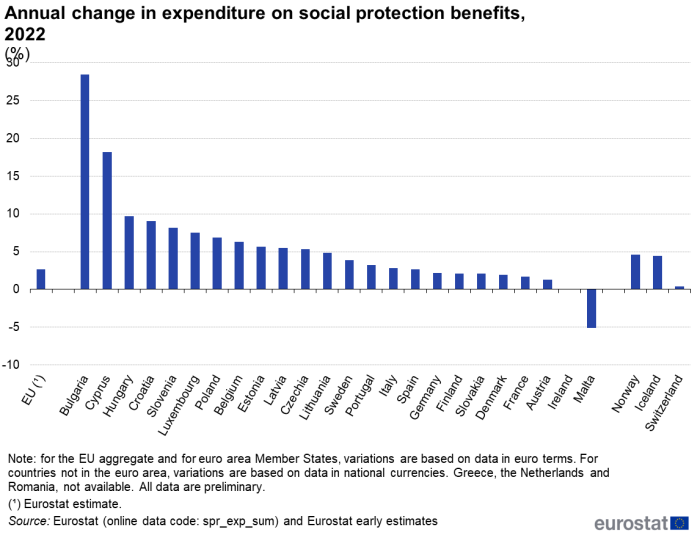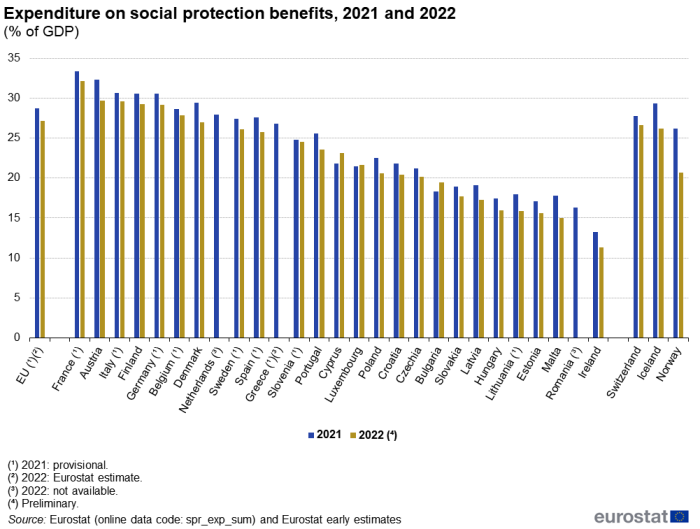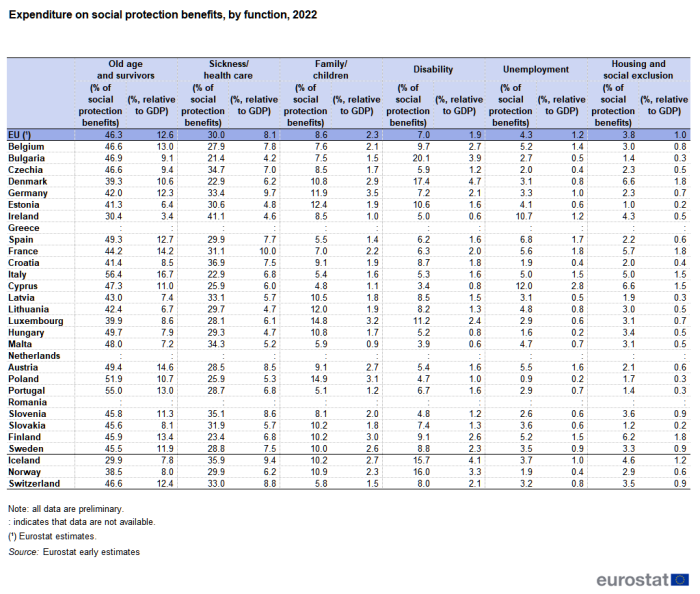Social protection statistics - early estimates
Data from October 2023.
Planned article update: November 2024.
Highlights
Total expenditure on social protection benefits in the EU was estimated at €4 307 billion in 2022, equivalent to 27.2 % of GDP.
In 2022, total expenditure on social protection benefits across the EU was 2.7 % higher than in 2021.
Annual change in expenditure on social protection benefits, 2022
The preliminary 2022 data on EU expenditure in 2022 show that EU countries spent €4 307 billion on social protection benefits, or 27.2 % of gross domestic product (GDP). This was an increase of 2.7 % compared to 2021.
There are considerable variations between EU countries when it comes to levels of social protection expenditure relative to GDP. This share ranges from 32.2 % in France to 11.3% in Ireland. The fastest increase in expenditure for social protection in 2022 was observed in Bulgaria (up 28.4 % compared to 2021), while Malta was the only country that recorded a decrease (down 5.1%).
The highest expenditure on social protection benefits was recorded for the old age and survivors function (mostly pensions), nearly half (46.3 %) of all expenditure on social protection benefits in 2022, followed by sickness/health care function, which accounted for 30.0 %.
This article presents statistics relating to expenditure on social protection benefits in the European Union (EU) and the EFTA countries. These statistics are collected through the European system of integrated social protection statistics (ESSPROS). The data for 2022 are early estimates published by Eurostat (on 31 October 2023); these preliminary data were provided by the reporting countries on a voluntary basis and are subject to revision.
Full article
Latest annual change in expenditure on social protection benefits
In 2022, the total expenditure on social protection benefits in the EU amounted to €4 307 billion, which was equivalent to 27.2 % of gross domestic product (GDP). Compared with 2021, this represented an increase of 2.7 % (in current price terms).
Among those EU Member States and EFTA countries for which data are published (see Figure 1), the annual change in expenditure on social protection benefits has been calculated in national currencies (thereby avoiding the influence of exchange rate fluctuations with respect to the euro). Note that for the EU aggregate and for euro area Member States, variations are based on data in euro terms.
- Across the Member States, the fastest increases in expenditure in 2022 (compared with 2021) were observed in Bulgaria [1] (up 28.4 %), Cyprus (up 18.2 %) and Hungary (up 9.7 %).
- Expenditure on social protection benefits rose at a relatively slow pace in 2022 in Denmark (up 1.9 %), France (up 1.7 %) and Austria (up 1.3 %), while there was no change in the level of expenditure in Ireland (0.0 %).
- Malta was the only Member State where the level of expenditure on social protection benefits was lower in 2022 than it had been in 2021 (down 5.1 %).

(%)
Source: Eurostat (spr_exp_sum) and Eurostat early estimates
Expenditure on social protection benefits relative to GDP
The ratio of expenditure on social protection benefits relative to GDP is influenced not only by the level of expenditure but also by developments in GDP. Between 2021 and 2022, this ratio fell in the EU from 28.7 % in 2021 to 27.2 % in 2022, down 1.5 percentage points (pp). This falling ratio results from GDP rising at a faster pace (up 8.7 % in nominal terms) than expenditure on social protection benefits (up 2.7 %).
In 2022, there were considerable variations between EU Member States with respect to their levels of expenditure on social protection benefits relative to GDP. There was a peak of 32.2 % in France, followed by Austria, Italy, Finland and Germany (with ratios in the range of 29–30 %). At the other end of the range, the lowest ratios were observed in Hungary (16.0 %), Lithuania (15.8 %), Estonia (15.6 %), Malta (15.0 %) and Ireland (11.3 %).
Across the 24 EU Member States for which data are published, the ratio of expenditure on social protection benefits relative to GDP:
- increased in Cyprus (up 1.4 pp), Bulgaria (up 1.2 pp) and Luxembourg (up 0.1 pp);
- fell in the remaining 21 Member States, the largest falls – at least 2.0 pp – were recorded in Portugal, Lithuania, Denmark, Austria and Malta (which had the largest decrease, down 2.8 pp).

(% of GDP)
Source: Eurostat (spr_exp_sum) and Eurostat early estimates
Expenditure on social protection benefits analysed by function
An analysis by function reveals that, within the EU, the highest expenditure on social protection benefits was recorded for the old age and survivors function (largely composed of pensions), which accounted for close to half (46.3 %) of all expenditure on social protection benefits in 2022. The next highest share was for the sickness/health care function, which accounted for three tenths (30.0 %) of the EU’s expenditure on social protection benefits, while each of the remaining four functions (shown in Table 1) accounted for single-digit shares. Among these, the highest proportion was recorded for the family/children function (8.6 % of total expenditure on social protection benefits), followed by the disability function (7.0 %), the unemployment function (4.3 %) and the housing and social exclusion function (3.8 %).

Source: Eurostat early estimates
As noted above, benefits for old age and survivors accounted for the highest share of EU expenditure on social protection benefits in 2022, at 46.3 %. This pattern was repeated in nearly all of the EU Member States. The one exception among the Member States was Ireland, where the sickness/health care function was the largest; among the EFTA countries, this situation was also observed in Iceland.
- There were three Member States where more than half of their total expenditure on social protection benefits was directed to the old age and survivors function, with a peak of 56.4 % in Italy, followed by Portugal (55.0 %) and Poland (51.9 %). In some cases, relatively high shares of expenditure on benefits for old age and survivors may be linked to population ageing (and its related costs).
- Apart from in Ireland, the second highest level of expenditure on social protection benefits across the Member States was for sickness/health care. Its share ranged from highs of 41.1 % in Ireland and 36.9 % in Croatia down to lows of 21.4 % in Bulgaria and 22.9 % in Denmark and Italy.
- The share of social protection benefits for family/children ranged from highs of 14.9 % in Poland and 14.8 % in Luxembourg down to a low of 4.8 % in Cyprus. In a majority (17) of the Member States, the family/children function accounted for the third highest level of benefits, as shown in Table 1.
- The highest shares of benefits in the disability function were recorded in Bulgaria (20.1 %), Denmark (17.4 %), Luxembourg (11.2 %) and Estonia (10.6 %); these were the only Member States where this function accounted for a double-digit share of total expenditure. There were much smaller shares recorded in Cyprus (3.4 %), Malta (3.9 %), Poland (4.7 %) and Slovenia (4.8 %). The disability function accounted for the third highest level of benefits in four Member States – Bulgaria, Denmark, Belgium and Portugal.
- The share of expenditure on unemployment benefits generally ranged from 1.6 % in Hungary up to 5.6 % in France. Poland (0.9 %) was below this range, while Spain (6.8 %), Ireland (10.7 %) and Cyprus (12.0 %) were above it. These three Member States –Cyprus, Ireland and Spain – were the only Member States where expenditure on the unemployment function accounted for the third highest level of social protection benefits, as shown in Table 1.
- Expenditure on housing and social exclusion as a share of total social protection benefits was higher in Denmark, Cyprus (both 6.6 %), Finland (6.2 %) and France (5.7 %) than in the other Member States. By contrast, in Estonia, Slovakia, Bulgaria and Portugal, the housing and social exclusion function accounted for less than 1.5 % of total expenditure on social protection benefits.
Source data for tables and graphs
![]() Social protection statistics – early estimates: tables and figures
Social protection statistics – early estimates: tables and figures
Data sources
The statistics presented in this article were collected from national statistical authorities and/or ministries of social affairs. For more information about the data sources, please refer to the data sources section of the main article on social protection statistics – social benefits.
Context
The main policy framework in the field of EU social protection is the European pillar of social rights.
Direct access to
- Social protection (spr), see:
- Social protection expenditure (spr_expend)
- For the early estimates, see:
- Social protection expenditure up in 2022 – Eurostat news – 14 November 2023
- Social protection methodology
- Social protection (ESMS metadata file — spr_esms)
- Regulation (EC) No 458/2007 of the European Parliament and of the Council of 25 April 2007 on the European system of integrated social protection statistics (Summary)
Notes
- ↑ The main increases in expenditure for Bulgaria are due to changes introduced in the methods of calculating old age (in particular pensions) and disability benefits.